Procurement and Contract Law
VerifiedAdded on 2023/03/21
|14
|4558
|22
AI Summary
This document discusses the common challenges faced by procurement and supply chain managers, the appraisal of contracting issues and legal implications for major projects, and the formation of relationships in supply chain management. It also provides solutions to overcome these challenges and develop an efficient supply chain.
Contribute Materials
Your contribution can guide someone’s learning journey. Share your
documents today.
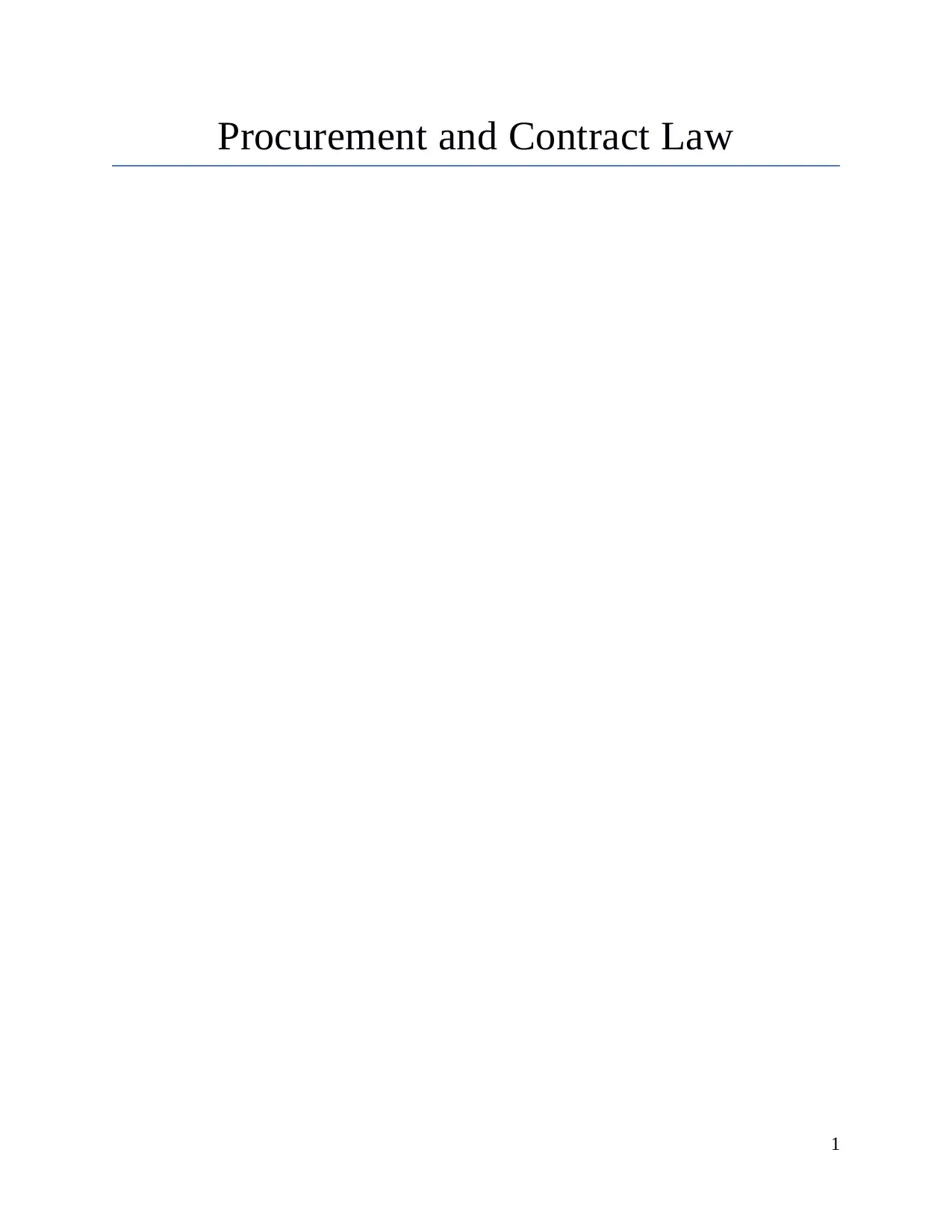
Procurement and Contract Law
1
1
Secure Best Marks with AI Grader
Need help grading? Try our AI Grader for instant feedback on your assignments.
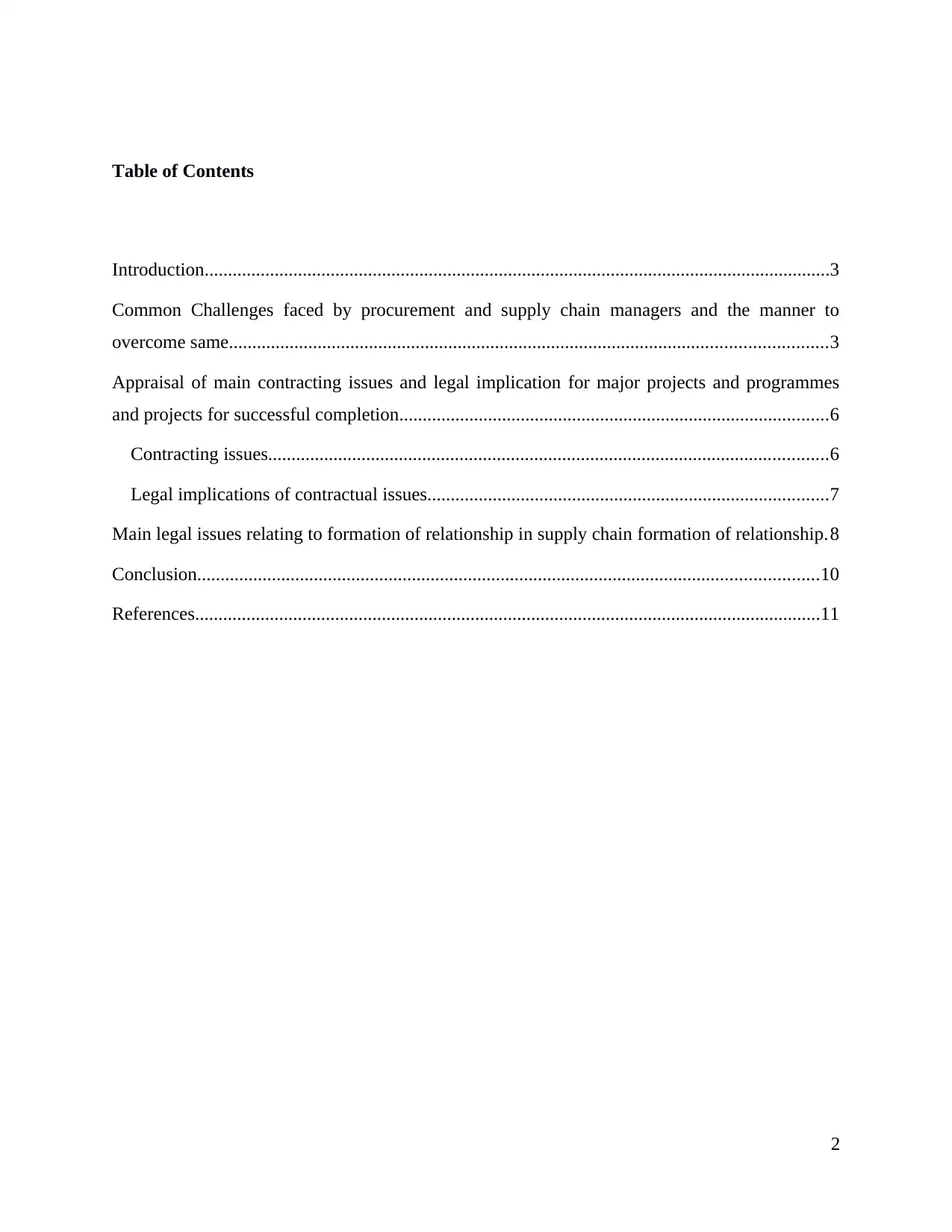
Table of Contents
Introduction......................................................................................................................................3
Common Challenges faced by procurement and supply chain managers and the manner to
overcome same................................................................................................................................3
Appraisal of main contracting issues and legal implication for major projects and programmes
and projects for successful completion............................................................................................6
Contracting issues........................................................................................................................6
Legal implications of contractual issues......................................................................................7
Main legal issues relating to formation of relationship in supply chain formation of relationship.8
Conclusion.....................................................................................................................................10
References......................................................................................................................................11
2
Introduction......................................................................................................................................3
Common Challenges faced by procurement and supply chain managers and the manner to
overcome same................................................................................................................................3
Appraisal of main contracting issues and legal implication for major projects and programmes
and projects for successful completion............................................................................................6
Contracting issues........................................................................................................................6
Legal implications of contractual issues......................................................................................7
Main legal issues relating to formation of relationship in supply chain formation of relationship.8
Conclusion.....................................................................................................................................10
References......................................................................................................................................11
2
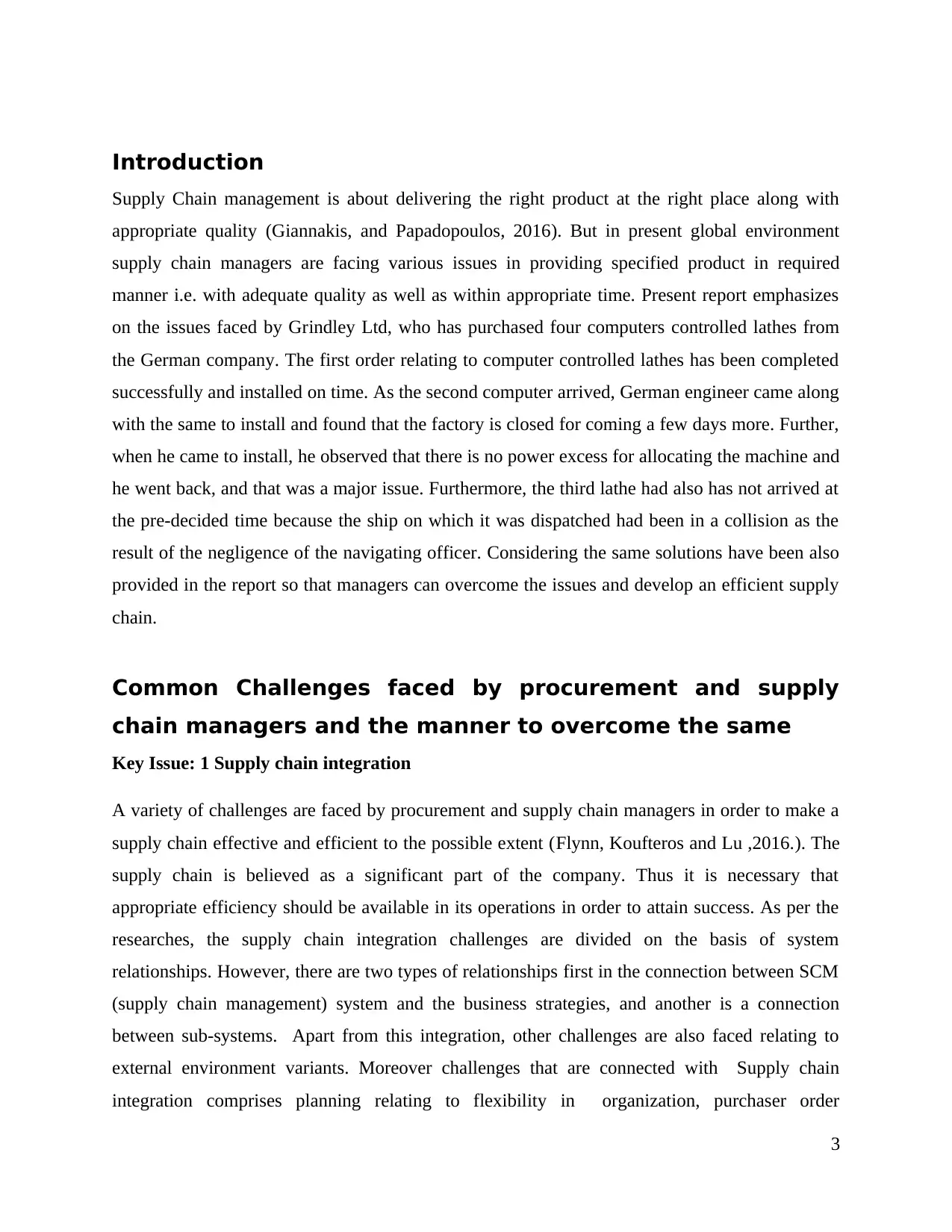
Introduction
Supply Chain management is about delivering the right product at the right place along with
appropriate quality (Giannakis, and Papadopoulos, 2016). But in present global environment
supply chain managers are facing various issues in providing specified product in required
manner i.e. with adequate quality as well as within appropriate time. Present report emphasizes
on the issues faced by Grindley Ltd, who has purchased four computers controlled lathes from
the German company. The first order relating to computer controlled lathes has been completed
successfully and installed on time. As the second computer arrived, German engineer came along
with the same to install and found that the factory is closed for coming a few days more. Further,
when he came to install, he observed that there is no power excess for allocating the machine and
he went back, and that was a major issue. Furthermore, the third lathe had also has not arrived at
the pre-decided time because the ship on which it was dispatched had been in a collision as the
result of the negligence of the navigating officer. Considering the same solutions have been also
provided in the report so that managers can overcome the issues and develop an efficient supply
chain.
Common Challenges faced by procurement and supply
chain managers and the manner to overcome the same
Key Issue: 1 Supply chain integration
A variety of challenges are faced by procurement and supply chain managers in order to make a
supply chain effective and efficient to the possible extent (Flynn, Koufteros and Lu ,2016.). The
supply chain is believed as a significant part of the company. Thus it is necessary that
appropriate efficiency should be available in its operations in order to attain success. As per the
researches, the supply chain integration challenges are divided on the basis of system
relationships. However, there are two types of relationships first in the connection between SCM
(supply chain management) system and the business strategies, and another is a connection
between sub-systems. Apart from this integration, other challenges are also faced relating to
external environment variants. Moreover challenges that are connected with Supply chain
integration comprises planning relating to flexibility in organization, purchaser order
3
Supply Chain management is about delivering the right product at the right place along with
appropriate quality (Giannakis, and Papadopoulos, 2016). But in present global environment
supply chain managers are facing various issues in providing specified product in required
manner i.e. with adequate quality as well as within appropriate time. Present report emphasizes
on the issues faced by Grindley Ltd, who has purchased four computers controlled lathes from
the German company. The first order relating to computer controlled lathes has been completed
successfully and installed on time. As the second computer arrived, German engineer came along
with the same to install and found that the factory is closed for coming a few days more. Further,
when he came to install, he observed that there is no power excess for allocating the machine and
he went back, and that was a major issue. Furthermore, the third lathe had also has not arrived at
the pre-decided time because the ship on which it was dispatched had been in a collision as the
result of the negligence of the navigating officer. Considering the same solutions have been also
provided in the report so that managers can overcome the issues and develop an efficient supply
chain.
Common Challenges faced by procurement and supply
chain managers and the manner to overcome the same
Key Issue: 1 Supply chain integration
A variety of challenges are faced by procurement and supply chain managers in order to make a
supply chain effective and efficient to the possible extent (Flynn, Koufteros and Lu ,2016.). The
supply chain is believed as a significant part of the company. Thus it is necessary that
appropriate efficiency should be available in its operations in order to attain success. As per the
researches, the supply chain integration challenges are divided on the basis of system
relationships. However, there are two types of relationships first in the connection between SCM
(supply chain management) system and the business strategies, and another is a connection
between sub-systems. Apart from this integration, other challenges are also faced relating to
external environment variants. Moreover challenges that are connected with Supply chain
integration comprises planning relating to flexibility in organization, purchaser order
3
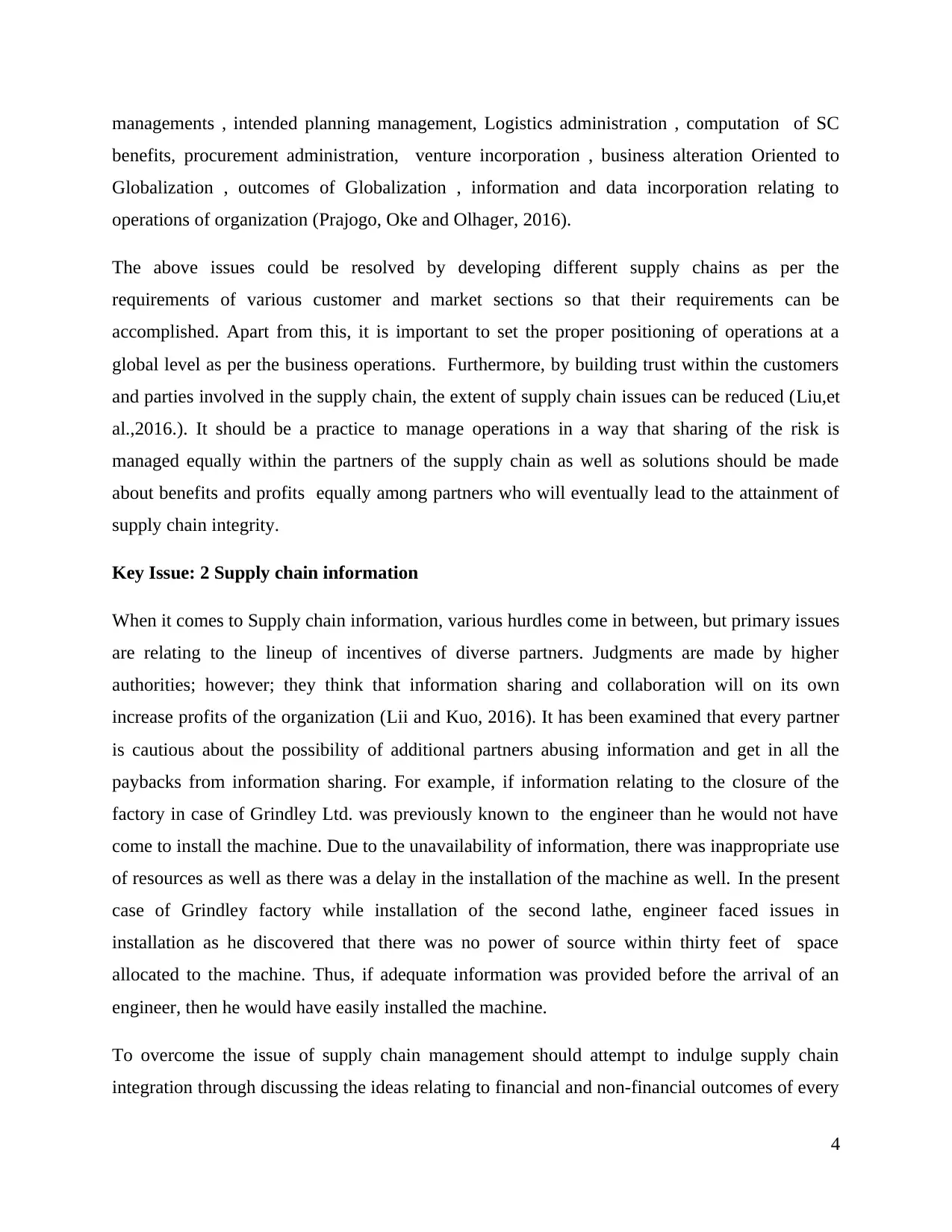
managements , intended planning management, Logistics administration , computation of SC
benefits, procurement administration, venture incorporation , business alteration Oriented to
Globalization , outcomes of Globalization , information and data incorporation relating to
operations of organization (Prajogo, Oke and Olhager, 2016).
The above issues could be resolved by developing different supply chains as per the
requirements of various customer and market sections so that their requirements can be
accomplished. Apart from this, it is important to set the proper positioning of operations at a
global level as per the business operations. Furthermore, by building trust within the customers
and parties involved in the supply chain, the extent of supply chain issues can be reduced (Liu,et
al.,2016.). It should be a practice to manage operations in a way that sharing of the risk is
managed equally within the partners of the supply chain as well as solutions should be made
about benefits and profits equally among partners who will eventually lead to the attainment of
supply chain integrity.
Key Issue: 2 Supply chain information
When it comes to Supply chain information, various hurdles come in between, but primary issues
are relating to the lineup of incentives of diverse partners. Judgments are made by higher
authorities; however; they think that information sharing and collaboration will on its own
increase profits of the organization (Lii and Kuo, 2016). It has been examined that every partner
is cautious about the possibility of additional partners abusing information and get in all the
paybacks from information sharing. For example, if information relating to the closure of the
factory in case of Grindley Ltd. was previously known to the engineer than he would not have
come to install the machine. Due to the unavailability of information, there was inappropriate use
of resources as well as there was a delay in the installation of the machine as well. In the present
case of Grindley factory while installation of the second lathe, engineer faced issues in
installation as he discovered that there was no power of source within thirty feet of space
allocated to the machine. Thus, if adequate information was provided before the arrival of an
engineer, then he would have easily installed the machine.
To overcome the issue of supply chain management should attempt to indulge supply chain
integration through discussing the ideas relating to financial and non-financial outcomes of every
4
benefits, procurement administration, venture incorporation , business alteration Oriented to
Globalization , outcomes of Globalization , information and data incorporation relating to
operations of organization (Prajogo, Oke and Olhager, 2016).
The above issues could be resolved by developing different supply chains as per the
requirements of various customer and market sections so that their requirements can be
accomplished. Apart from this, it is important to set the proper positioning of operations at a
global level as per the business operations. Furthermore, by building trust within the customers
and parties involved in the supply chain, the extent of supply chain issues can be reduced (Liu,et
al.,2016.). It should be a practice to manage operations in a way that sharing of the risk is
managed equally within the partners of the supply chain as well as solutions should be made
about benefits and profits equally among partners who will eventually lead to the attainment of
supply chain integrity.
Key Issue: 2 Supply chain information
When it comes to Supply chain information, various hurdles come in between, but primary issues
are relating to the lineup of incentives of diverse partners. Judgments are made by higher
authorities; however; they think that information sharing and collaboration will on its own
increase profits of the organization (Lii and Kuo, 2016). It has been examined that every partner
is cautious about the possibility of additional partners abusing information and get in all the
paybacks from information sharing. For example, if information relating to the closure of the
factory in case of Grindley Ltd. was previously known to the engineer than he would not have
come to install the machine. Due to the unavailability of information, there was inappropriate use
of resources as well as there was a delay in the installation of the machine as well. In the present
case of Grindley factory while installation of the second lathe, engineer faced issues in
installation as he discovered that there was no power of source within thirty feet of space
allocated to the machine. Thus, if adequate information was provided before the arrival of an
engineer, then he would have easily installed the machine.
To overcome the issue of supply chain management should attempt to indulge supply chain
integration through discussing the ideas relating to financial and non-financial outcomes of every
4
Secure Best Marks with AI Grader
Need help grading? Try our AI Grader for instant feedback on your assignments.
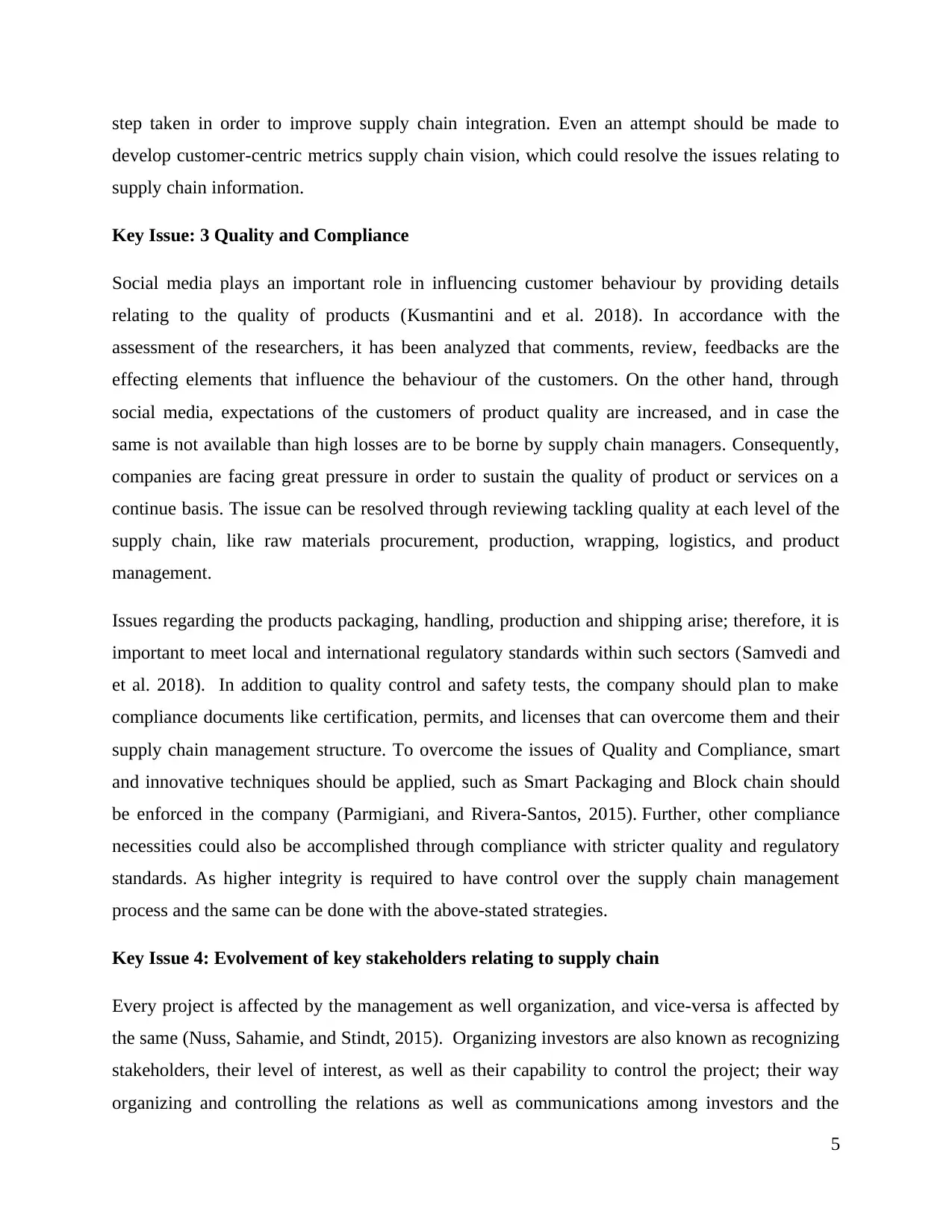
step taken in order to improve supply chain integration. Even an attempt should be made to
develop customer-centric metrics supply chain vision, which could resolve the issues relating to
supply chain information.
Key Issue: 3 Quality and Compliance
Social media plays an important role in influencing customer behaviour by providing details
relating to the quality of products (Kusmantini and et al. 2018). In accordance with the
assessment of the researchers, it has been analyzed that comments, review, feedbacks are the
effecting elements that influence the behaviour of the customers. On the other hand, through
social media, expectations of the customers of product quality are increased, and in case the
same is not available than high losses are to be borne by supply chain managers. Consequently,
companies are facing great pressure in order to sustain the quality of product or services on a
continue basis. The issue can be resolved through reviewing tackling quality at each level of the
supply chain, like raw materials procurement, production, wrapping, logistics, and product
management.
Issues regarding the products packaging, handling, production and shipping arise; therefore, it is
important to meet local and international regulatory standards within such sectors (Samvedi and
et al. 2018). In addition to quality control and safety tests, the company should plan to make
compliance documents like certification, permits, and licenses that can overcome them and their
supply chain management structure. To overcome the issues of Quality and Compliance, smart
and innovative techniques should be applied, such as Smart Packaging and Block chain should
be enforced in the company (Parmigiani, and Rivera-Santos, 2015). Further, other compliance
necessities could also be accomplished through compliance with stricter quality and regulatory
standards. As higher integrity is required to have control over the supply chain management
process and the same can be done with the above-stated strategies.
Key Issue 4: Evolvement of key stakeholders relating to supply chain
Every project is affected by the management as well organization, and vice-versa is affected by
the same (Nuss, Sahamie, and Stindt, 2015). Organizing investors are also known as recognizing
stakeholders, their level of interest, as well as their capability to control the project; their way
organizing and controlling the relations as well as communications among investors and the
5
develop customer-centric metrics supply chain vision, which could resolve the issues relating to
supply chain information.
Key Issue: 3 Quality and Compliance
Social media plays an important role in influencing customer behaviour by providing details
relating to the quality of products (Kusmantini and et al. 2018). In accordance with the
assessment of the researchers, it has been analyzed that comments, review, feedbacks are the
effecting elements that influence the behaviour of the customers. On the other hand, through
social media, expectations of the customers of product quality are increased, and in case the
same is not available than high losses are to be borne by supply chain managers. Consequently,
companies are facing great pressure in order to sustain the quality of product or services on a
continue basis. The issue can be resolved through reviewing tackling quality at each level of the
supply chain, like raw materials procurement, production, wrapping, logistics, and product
management.
Issues regarding the products packaging, handling, production and shipping arise; therefore, it is
important to meet local and international regulatory standards within such sectors (Samvedi and
et al. 2018). In addition to quality control and safety tests, the company should plan to make
compliance documents like certification, permits, and licenses that can overcome them and their
supply chain management structure. To overcome the issues of Quality and Compliance, smart
and innovative techniques should be applied, such as Smart Packaging and Block chain should
be enforced in the company (Parmigiani, and Rivera-Santos, 2015). Further, other compliance
necessities could also be accomplished through compliance with stricter quality and regulatory
standards. As higher integrity is required to have control over the supply chain management
process and the same can be done with the above-stated strategies.
Key Issue 4: Evolvement of key stakeholders relating to supply chain
Every project is affected by the management as well organization, and vice-versa is affected by
the same (Nuss, Sahamie, and Stindt, 2015). Organizing investors are also known as recognizing
stakeholders, their level of interest, as well as their capability to control the project; their way
organizing and controlling the relations as well as communications among investors and the
5
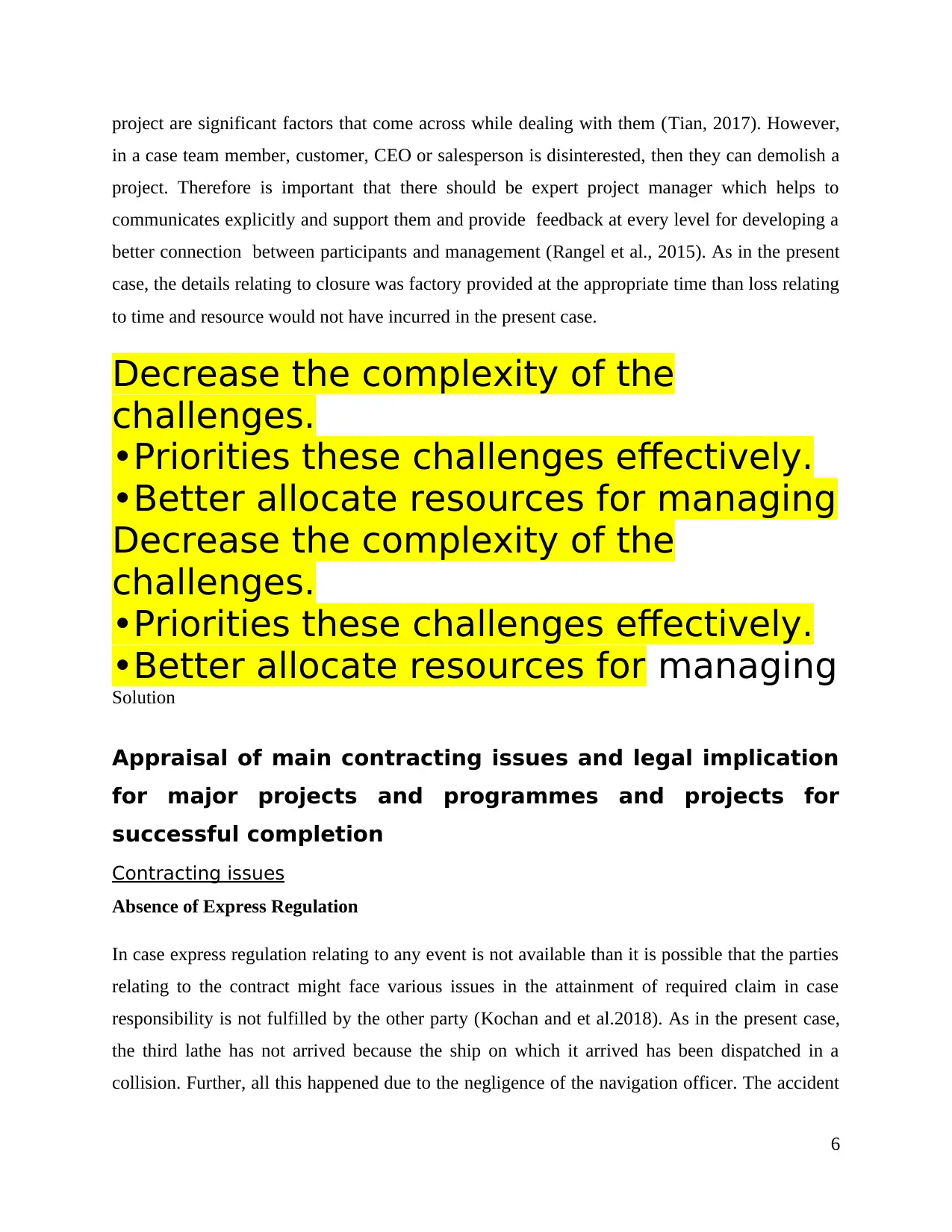
project are significant factors that come across while dealing with them (Tian, 2017). However,
in a case team member, customer, CEO or salesperson is disinterested, then they can demolish a
project. Therefore is important that there should be expert project manager which helps to
communicates explicitly and support them and provide feedback at every level for developing a
better connection between participants and management (Rangel et al., 2015). As in the present
case, the details relating to closure was factory provided at the appropriate time than loss relating
to time and resource would not have incurred in the present case.
Decrease the complexity of the
challenges.
•Priorities these challenges effectively.
•Better allocate resources for managing
Decrease the complexity of the
challenges.
•Priorities these challenges effectively.
•Better allocate resources for managing
Solution
Appraisal of main contracting issues and legal implication
for major projects and programmes and projects for
successful completion
Contracting issues
Absence of Express Regulation
In case express regulation relating to any event is not available than it is possible that the parties
relating to the contract might face various issues in the attainment of required claim in case
responsibility is not fulfilled by the other party (Kochan and et al.2018). As in the present case,
the third lathe has not arrived because the ship on which it arrived has been dispatched in a
collision. Further, all this happened due to the negligence of the navigation officer. The accident
6
in a case team member, customer, CEO or salesperson is disinterested, then they can demolish a
project. Therefore is important that there should be expert project manager which helps to
communicates explicitly and support them and provide feedback at every level for developing a
better connection between participants and management (Rangel et al., 2015). As in the present
case, the details relating to closure was factory provided at the appropriate time than loss relating
to time and resource would not have incurred in the present case.
Decrease the complexity of the
challenges.
•Priorities these challenges effectively.
•Better allocate resources for managing
Decrease the complexity of the
challenges.
•Priorities these challenges effectively.
•Better allocate resources for managing
Solution
Appraisal of main contracting issues and legal implication
for major projects and programmes and projects for
successful completion
Contracting issues
Absence of Express Regulation
In case express regulation relating to any event is not available than it is possible that the parties
relating to the contract might face various issues in the attainment of required claim in case
responsibility is not fulfilled by the other party (Kochan and et al.2018). As in the present case,
the third lathe has not arrived because the ship on which it arrived has been dispatched in a
collision. Further, all this happened due to the negligence of the navigation officer. The accident
6
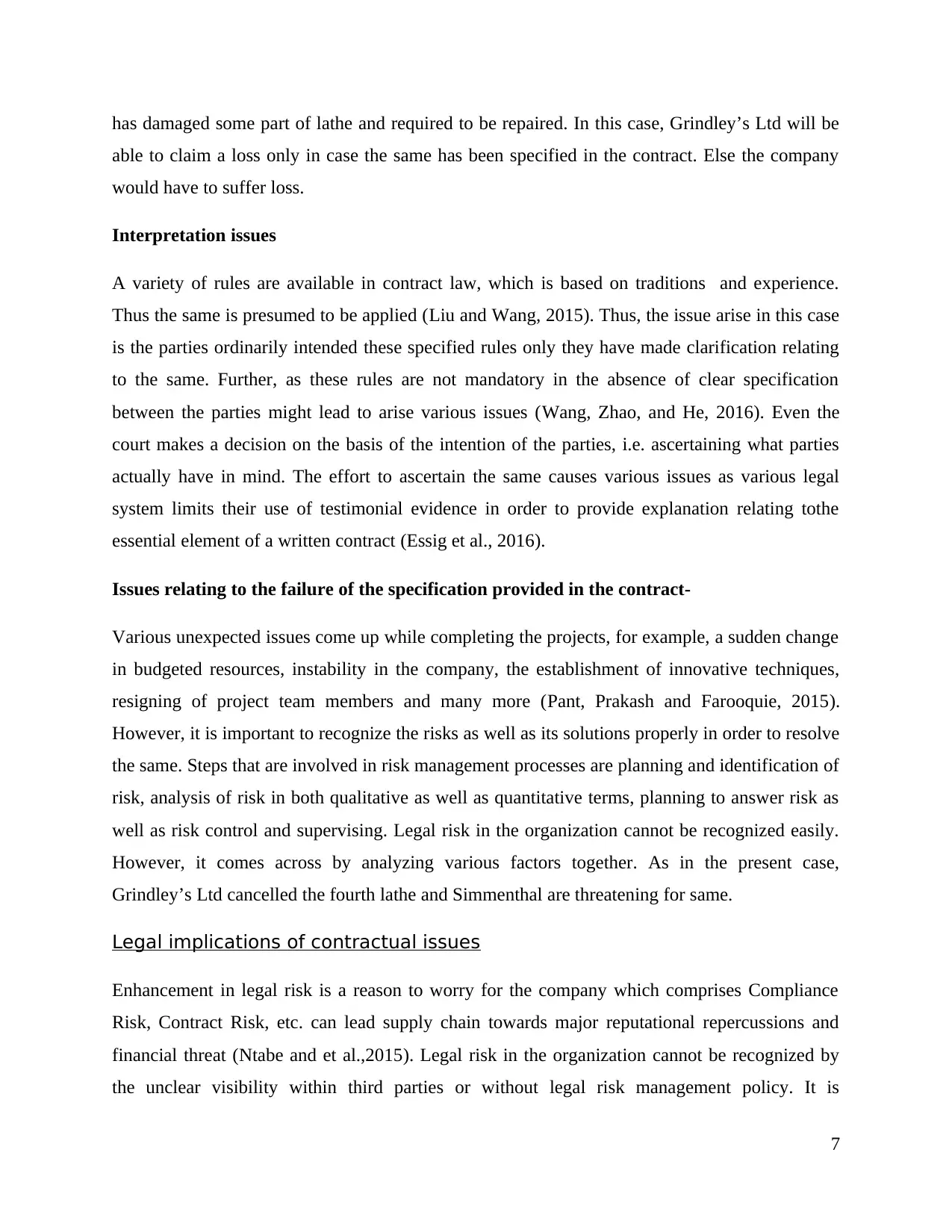
has damaged some part of lathe and required to be repaired. In this case, Grindley’s Ltd will be
able to claim a loss only in case the same has been specified in the contract. Else the company
would have to suffer loss.
Interpretation issues
A variety of rules are available in contract law, which is based on traditions and experience.
Thus the same is presumed to be applied (Liu and Wang, 2015). Thus, the issue arise in this case
is the parties ordinarily intended these specified rules only they have made clarification relating
to the same. Further, as these rules are not mandatory in the absence of clear specification
between the parties might lead to arise various issues (Wang, Zhao, and He, 2016). Even the
court makes a decision on the basis of the intention of the parties, i.e. ascertaining what parties
actually have in mind. The effort to ascertain the same causes various issues as various legal
system limits their use of testimonial evidence in order to provide explanation relating tothe
essential element of a written contract (Essig et al., 2016).
Issues relating to the failure of the specification provided in the contract-
Various unexpected issues come up while completing the projects, for example, a sudden change
in budgeted resources, instability in the company, the establishment of innovative techniques,
resigning of project team members and many more (Pant, Prakash and Farooquie, 2015).
However, it is important to recognize the risks as well as its solutions properly in order to resolve
the same. Steps that are involved in risk management processes are planning and identification of
risk, analysis of risk in both qualitative as well as quantitative terms, planning to answer risk as
well as risk control and supervising. Legal risk in the organization cannot be recognized easily.
However, it comes across by analyzing various factors together. As in the present case,
Grindley’s Ltd cancelled the fourth lathe and Simmenthal are threatening for same.
Legal implications of contractual issues
Enhancement in legal risk is a reason to worry for the company which comprises Compliance
Risk, Contract Risk, etc. can lead supply chain towards major reputational repercussions and
financial threat (Ntabe and et al.,2015). Legal risk in the organization cannot be recognized by
the unclear visibility within third parties or without legal risk management policy. It is
7
able to claim a loss only in case the same has been specified in the contract. Else the company
would have to suffer loss.
Interpretation issues
A variety of rules are available in contract law, which is based on traditions and experience.
Thus the same is presumed to be applied (Liu and Wang, 2015). Thus, the issue arise in this case
is the parties ordinarily intended these specified rules only they have made clarification relating
to the same. Further, as these rules are not mandatory in the absence of clear specification
between the parties might lead to arise various issues (Wang, Zhao, and He, 2016). Even the
court makes a decision on the basis of the intention of the parties, i.e. ascertaining what parties
actually have in mind. The effort to ascertain the same causes various issues as various legal
system limits their use of testimonial evidence in order to provide explanation relating tothe
essential element of a written contract (Essig et al., 2016).
Issues relating to the failure of the specification provided in the contract-
Various unexpected issues come up while completing the projects, for example, a sudden change
in budgeted resources, instability in the company, the establishment of innovative techniques,
resigning of project team members and many more (Pant, Prakash and Farooquie, 2015).
However, it is important to recognize the risks as well as its solutions properly in order to resolve
the same. Steps that are involved in risk management processes are planning and identification of
risk, analysis of risk in both qualitative as well as quantitative terms, planning to answer risk as
well as risk control and supervising. Legal risk in the organization cannot be recognized easily.
However, it comes across by analyzing various factors together. As in the present case,
Grindley’s Ltd cancelled the fourth lathe and Simmenthal are threatening for same.
Legal implications of contractual issues
Enhancement in legal risk is a reason to worry for the company which comprises Compliance
Risk, Contract Risk, etc. can lead supply chain towards major reputational repercussions and
financial threat (Ntabe and et al.,2015). Legal risk in the organization cannot be recognized by
the unclear visibility within third parties or without legal risk management policy. It is
7
Paraphrase This Document
Need a fresh take? Get an instant paraphrase of this document with our AI Paraphraser
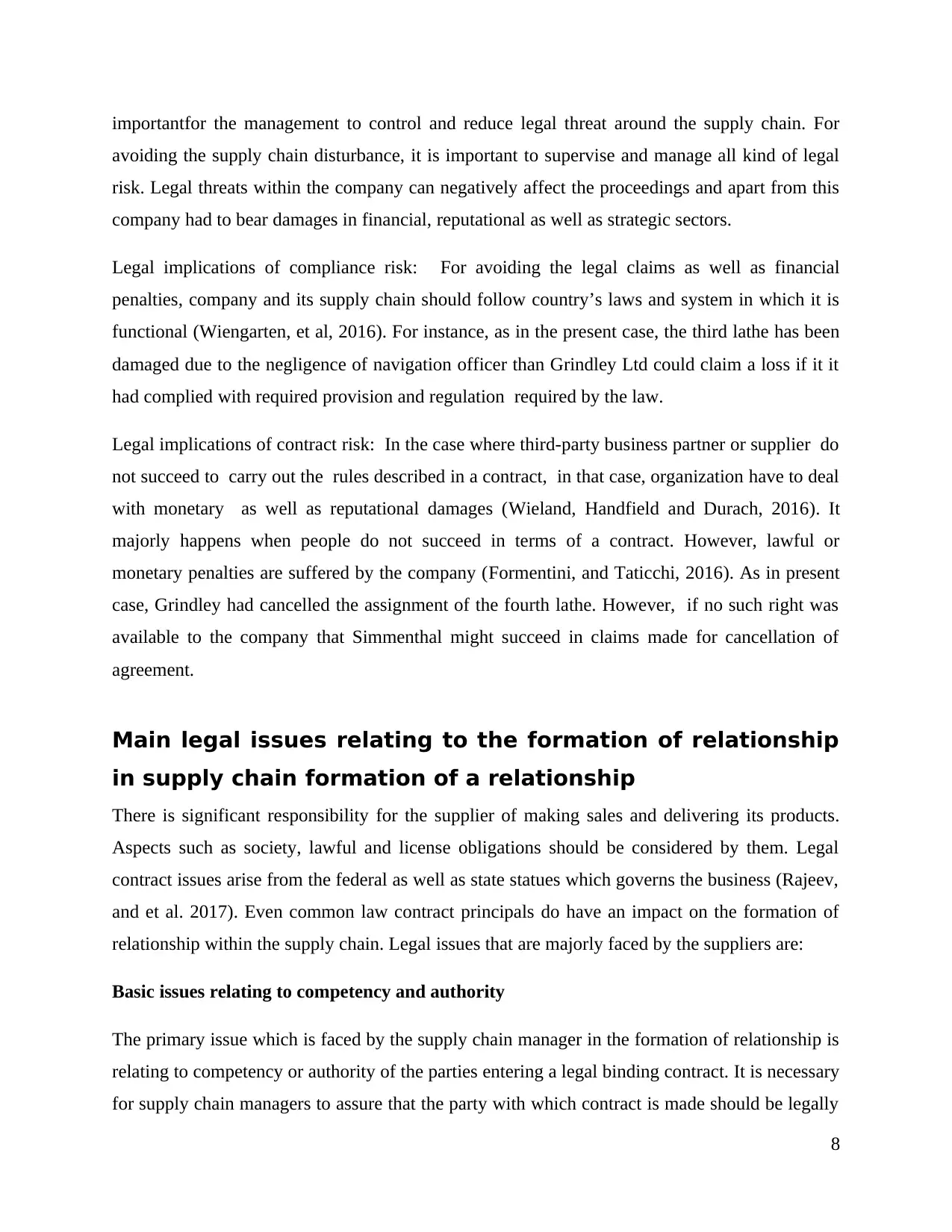
importantfor the management to control and reduce legal threat around the supply chain. For
avoiding the supply chain disturbance, it is important to supervise and manage all kind of legal
risk. Legal threats within the company can negatively affect the proceedings and apart from this
company had to bear damages in financial, reputational as well as strategic sectors.
Legal implications of compliance risk: For avoiding the legal claims as well as financial
penalties, company and its supply chain should follow country’s laws and system in which it is
functional (Wiengarten, et al, 2016). For instance, as in the present case, the third lathe has been
damaged due to the negligence of navigation officer than Grindley Ltd could claim a loss if it it
had complied with required provision and regulation required by the law.
Legal implications of contract risk: In the case where third-party business partner or supplier do
not succeed to carry out the rules described in a contract, in that case, organization have to deal
with monetary as well as reputational damages (Wieland, Handfield and Durach, 2016). It
majorly happens when people do not succeed in terms of a contract. However, lawful or
monetary penalties are suffered by the company (Formentini, and Taticchi, 2016). As in present
case, Grindley had cancelled the assignment of the fourth lathe. However, if no such right was
available to the company that Simmenthal might succeed in claims made for cancellation of
agreement.
Main legal issues relating to the formation of relationship
in supply chain formation of a relationship
There is significant responsibility for the supplier of making sales and delivering its products.
Aspects such as society, lawful and license obligations should be considered by them. Legal
contract issues arise from the federal as well as state statues which governs the business (Rajeev,
and et al. 2017). Even common law contract principals do have an impact on the formation of
relationship within the supply chain. Legal issues that are majorly faced by the suppliers are:
Basic issues relating to competency and authority
The primary issue which is faced by the supply chain manager in the formation of relationship is
relating to competency or authority of the parties entering a legal binding contract. It is necessary
for supply chain managers to assure that the party with which contract is made should be legally
8
avoiding the supply chain disturbance, it is important to supervise and manage all kind of legal
risk. Legal threats within the company can negatively affect the proceedings and apart from this
company had to bear damages in financial, reputational as well as strategic sectors.
Legal implications of compliance risk: For avoiding the legal claims as well as financial
penalties, company and its supply chain should follow country’s laws and system in which it is
functional (Wiengarten, et al, 2016). For instance, as in the present case, the third lathe has been
damaged due to the negligence of navigation officer than Grindley Ltd could claim a loss if it it
had complied with required provision and regulation required by the law.
Legal implications of contract risk: In the case where third-party business partner or supplier do
not succeed to carry out the rules described in a contract, in that case, organization have to deal
with monetary as well as reputational damages (Wieland, Handfield and Durach, 2016). It
majorly happens when people do not succeed in terms of a contract. However, lawful or
monetary penalties are suffered by the company (Formentini, and Taticchi, 2016). As in present
case, Grindley had cancelled the assignment of the fourth lathe. However, if no such right was
available to the company that Simmenthal might succeed in claims made for cancellation of
agreement.
Main legal issues relating to the formation of relationship
in supply chain formation of a relationship
There is significant responsibility for the supplier of making sales and delivering its products.
Aspects such as society, lawful and license obligations should be considered by them. Legal
contract issues arise from the federal as well as state statues which governs the business (Rajeev,
and et al. 2017). Even common law contract principals do have an impact on the formation of
relationship within the supply chain. Legal issues that are majorly faced by the suppliers are:
Basic issues relating to competency and authority
The primary issue which is faced by the supply chain manager in the formation of relationship is
relating to competency or authority of the parties entering a legal binding contract. It is necessary
for supply chain managers to assure that the party with which contract is made should be legally
8
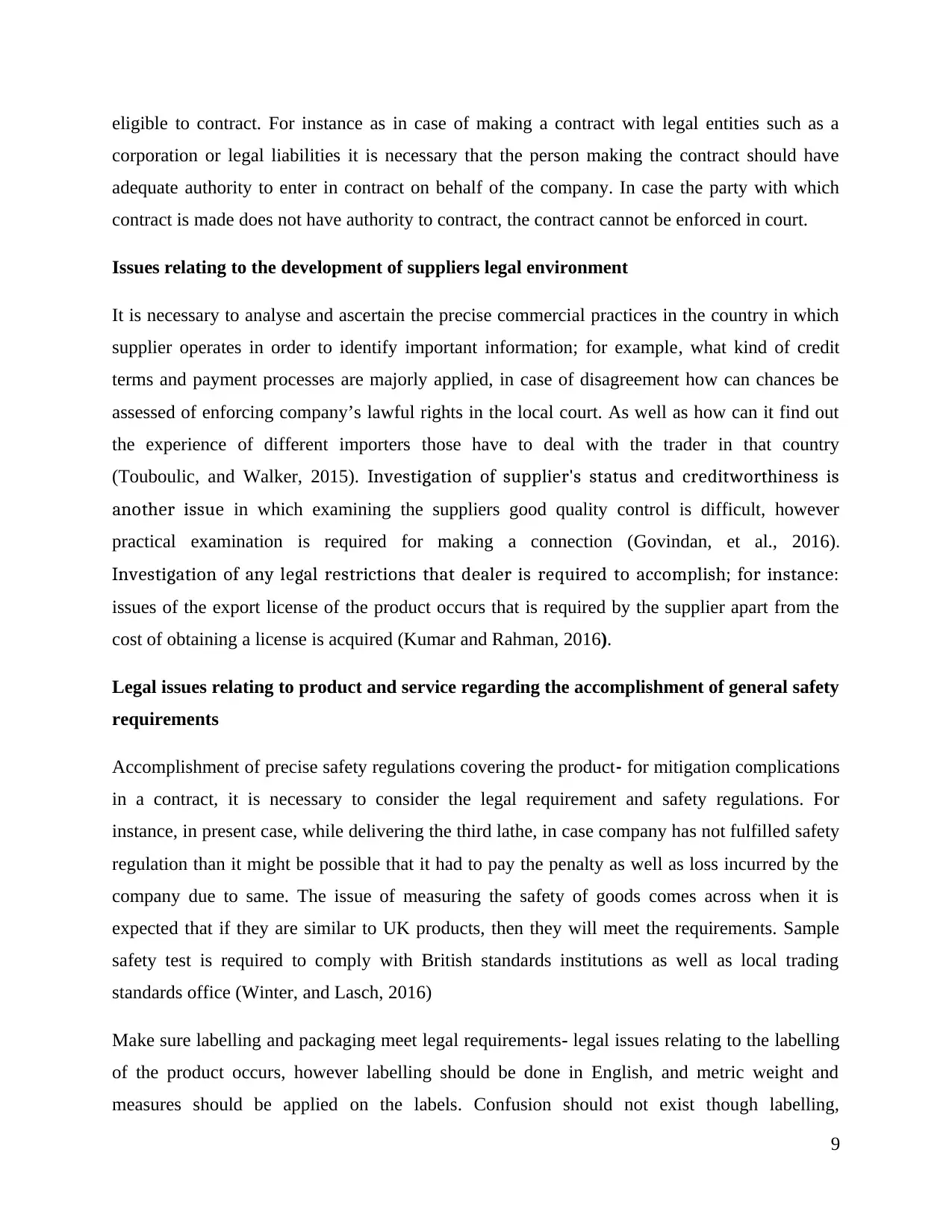
eligible to contract. For instance as in case of making a contract with legal entities such as a
corporation or legal liabilities it is necessary that the person making the contract should have
adequate authority to enter in contract on behalf of the company. In case the party with which
contract is made does not have authority to contract, the contract cannot be enforced in court.
Issues relating to the development of suppliers legal environment
It is necessary to analyse and ascertain the precise commercial practices in the country in which
supplier operates in order to identify important information; for example, what kind of credit
terms and payment processes are majorly applied, in case of disagreement how can chances be
assessed of enforcing company’s lawful rights in the local court. As well as how can it find out
the experience of different importers those have to deal with the trader in that country
(Touboulic, and Walker, 2015). Investigation of supplier's status and creditworthiness is
another issue in which examining the suppliers good quality control is difficult, however
practical examination is required for making a connection (Govindan, et al., 2016).
Investigation of any legal restrictions that dealer is required to accomplish; for instance:
issues of the export license of the product occurs that is required by the supplier apart from the
cost of obtaining a license is acquired (Kumar and Rahman, 2016).
Legal issues relating to product and service regarding the accomplishment of general safety
requirements
Accomplishment of precise safety regulations covering the product- for mitigation complications
in a contract, it is necessary to consider the legal requirement and safety regulations. For
instance, in present case, while delivering the third lathe, in case company has not fulfilled safety
regulation than it might be possible that it had to pay the penalty as well as loss incurred by the
company due to same. The issue of measuring the safety of goods comes across when it is
expected that if they are similar to UK products, then they will meet the requirements. Sample
safety test is required to comply with British standards institutions as well as local trading
standards office (Winter, and Lasch, 2016)
Make sure labelling and packaging meet legal requirements- legal issues relating to the labelling
of the product occurs, however labelling should be done in English, and metric weight and
measures should be applied on the labels. Confusion should not exist though labelling,
9
corporation or legal liabilities it is necessary that the person making the contract should have
adequate authority to enter in contract on behalf of the company. In case the party with which
contract is made does not have authority to contract, the contract cannot be enforced in court.
Issues relating to the development of suppliers legal environment
It is necessary to analyse and ascertain the precise commercial practices in the country in which
supplier operates in order to identify important information; for example, what kind of credit
terms and payment processes are majorly applied, in case of disagreement how can chances be
assessed of enforcing company’s lawful rights in the local court. As well as how can it find out
the experience of different importers those have to deal with the trader in that country
(Touboulic, and Walker, 2015). Investigation of supplier's status and creditworthiness is
another issue in which examining the suppliers good quality control is difficult, however
practical examination is required for making a connection (Govindan, et al., 2016).
Investigation of any legal restrictions that dealer is required to accomplish; for instance:
issues of the export license of the product occurs that is required by the supplier apart from the
cost of obtaining a license is acquired (Kumar and Rahman, 2016).
Legal issues relating to product and service regarding the accomplishment of general safety
requirements
Accomplishment of precise safety regulations covering the product- for mitigation complications
in a contract, it is necessary to consider the legal requirement and safety regulations. For
instance, in present case, while delivering the third lathe, in case company has not fulfilled safety
regulation than it might be possible that it had to pay the penalty as well as loss incurred by the
company due to same. The issue of measuring the safety of goods comes across when it is
expected that if they are similar to UK products, then they will meet the requirements. Sample
safety test is required to comply with British standards institutions as well as local trading
standards office (Winter, and Lasch, 2016)
Make sure labelling and packaging meet legal requirements- legal issues relating to the labelling
of the product occurs, however labelling should be done in English, and metric weight and
measures should be applied on the labels. Confusion should not exist though labelling,
9
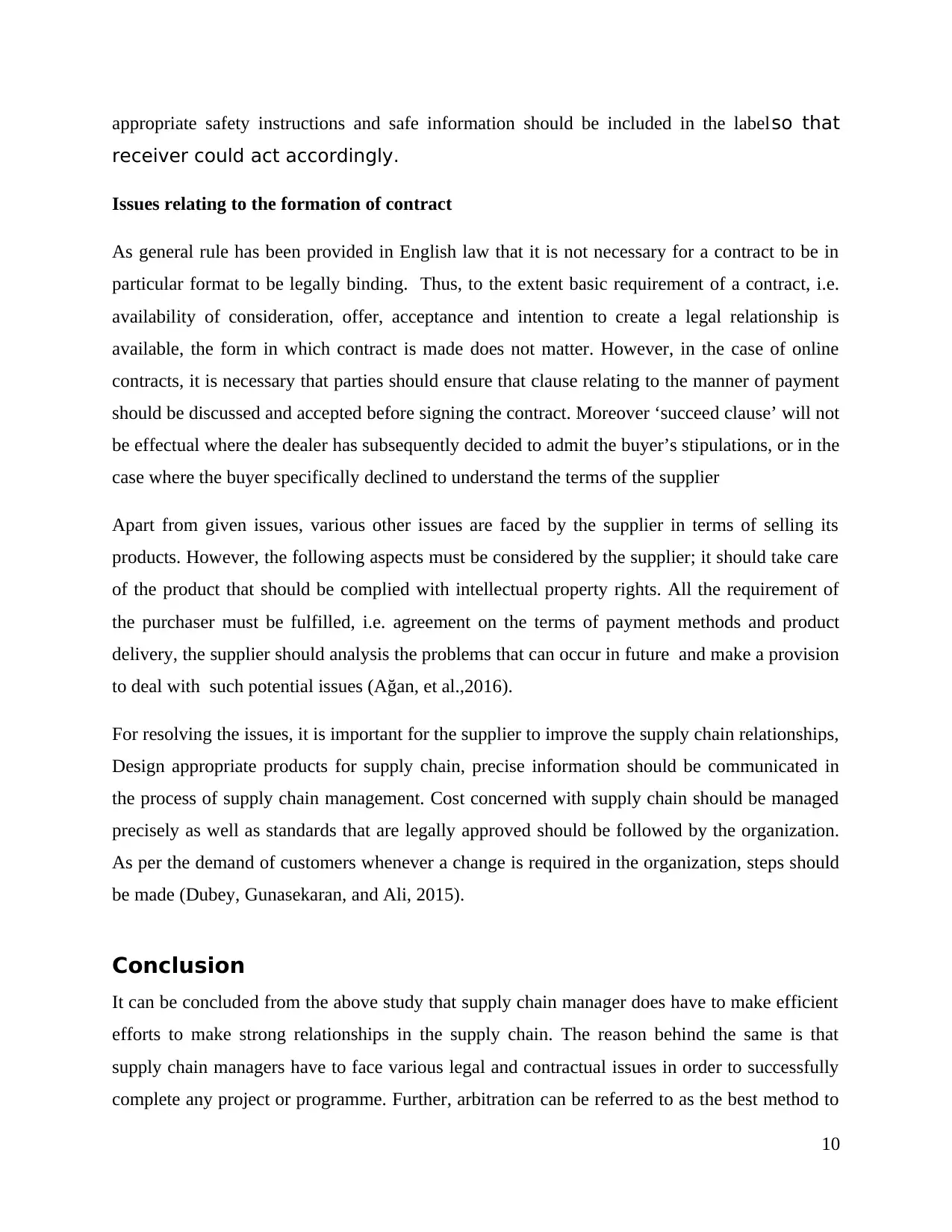
appropriate safety instructions and safe information should be included in the labelso that
receiver could act accordingly.
Issues relating to the formation of contract
As general rule has been provided in English law that it is not necessary for a contract to be in
particular format to be legally binding. Thus, to the extent basic requirement of a contract, i.e.
availability of consideration, offer, acceptance and intention to create a legal relationship is
available, the form in which contract is made does not matter. However, in the case of online
contracts, it is necessary that parties should ensure that clause relating to the manner of payment
should be discussed and accepted before signing the contract. Moreover ‘succeed clause’ will not
be effectual where the dealer has subsequently decided to admit the buyer’s stipulations, or in the
case where the buyer specifically declined to understand the terms of the supplier
Apart from given issues, various other issues are faced by the supplier in terms of selling its
products. However, the following aspects must be considered by the supplier; it should take care
of the product that should be complied with intellectual property rights. All the requirement of
the purchaser must be fulfilled, i.e. agreement on the terms of payment methods and product
delivery, the supplier should analysis the problems that can occur in future and make a provision
to deal with such potential issues (Ağan, et al.,2016).
For resolving the issues, it is important for the supplier to improve the supply chain relationships,
Design appropriate products for supply chain, precise information should be communicated in
the process of supply chain management. Cost concerned with supply chain should be managed
precisely as well as standards that are legally approved should be followed by the organization.
As per the demand of customers whenever a change is required in the organization, steps should
be made (Dubey, Gunasekaran, and Ali, 2015).
Conclusion
It can be concluded from the above study that supply chain manager does have to make efficient
efforts to make strong relationships in the supply chain. The reason behind the same is that
supply chain managers have to face various legal and contractual issues in order to successfully
complete any project or programme. Further, arbitration can be referred to as the best method to
10
receiver could act accordingly.
Issues relating to the formation of contract
As general rule has been provided in English law that it is not necessary for a contract to be in
particular format to be legally binding. Thus, to the extent basic requirement of a contract, i.e.
availability of consideration, offer, acceptance and intention to create a legal relationship is
available, the form in which contract is made does not matter. However, in the case of online
contracts, it is necessary that parties should ensure that clause relating to the manner of payment
should be discussed and accepted before signing the contract. Moreover ‘succeed clause’ will not
be effectual where the dealer has subsequently decided to admit the buyer’s stipulations, or in the
case where the buyer specifically declined to understand the terms of the supplier
Apart from given issues, various other issues are faced by the supplier in terms of selling its
products. However, the following aspects must be considered by the supplier; it should take care
of the product that should be complied with intellectual property rights. All the requirement of
the purchaser must be fulfilled, i.e. agreement on the terms of payment methods and product
delivery, the supplier should analysis the problems that can occur in future and make a provision
to deal with such potential issues (Ağan, et al.,2016).
For resolving the issues, it is important for the supplier to improve the supply chain relationships,
Design appropriate products for supply chain, precise information should be communicated in
the process of supply chain management. Cost concerned with supply chain should be managed
precisely as well as standards that are legally approved should be followed by the organization.
As per the demand of customers whenever a change is required in the organization, steps should
be made (Dubey, Gunasekaran, and Ali, 2015).
Conclusion
It can be concluded from the above study that supply chain manager does have to make efficient
efforts to make strong relationships in the supply chain. The reason behind the same is that
supply chain managers have to face various legal and contractual issues in order to successfully
complete any project or programme. Further, arbitration can be referred to as the best method to
10
Secure Best Marks with AI Grader
Need help grading? Try our AI Grader for instant feedback on your assignments.
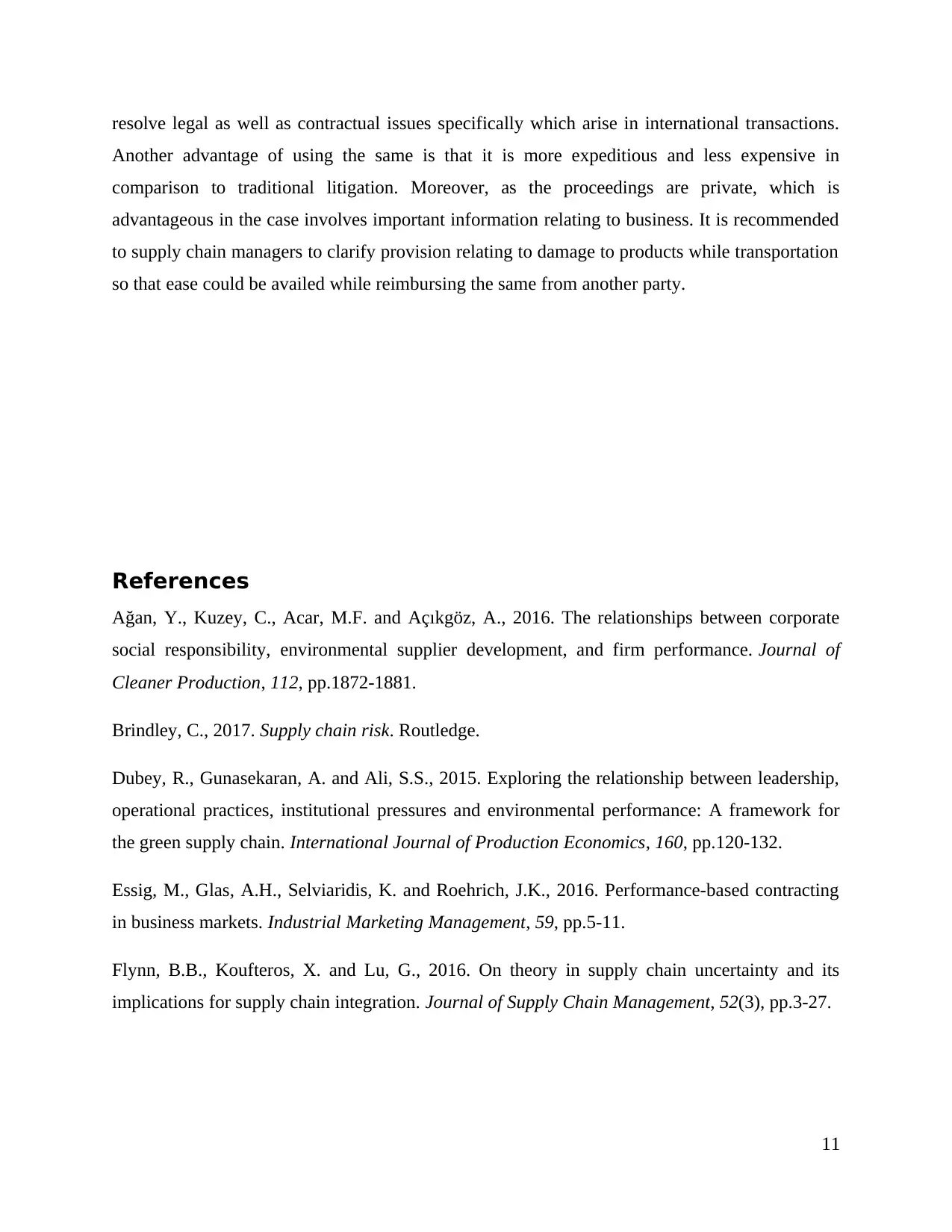
resolve legal as well as contractual issues specifically which arise in international transactions.
Another advantage of using the same is that it is more expeditious and less expensive in
comparison to traditional litigation. Moreover, as the proceedings are private, which is
advantageous in the case involves important information relating to business. It is recommended
to supply chain managers to clarify provision relating to damage to products while transportation
so that ease could be availed while reimbursing the same from another party.
References
Ağan, Y., Kuzey, C., Acar, M.F. and Açıkgöz, A., 2016. The relationships between corporate
social responsibility, environmental supplier development, and firm performance. Journal of
Cleaner Production, 112, pp.1872-1881.
Brindley, C., 2017. Supply chain risk. Routledge.
Dubey, R., Gunasekaran, A. and Ali, S.S., 2015. Exploring the relationship between leadership,
operational practices, institutional pressures and environmental performance: A framework for
the green supply chain. International Journal of Production Economics, 160, pp.120-132.
Essig, M., Glas, A.H., Selviaridis, K. and Roehrich, J.K., 2016. Performance-based contracting
in business markets. Industrial Marketing Management, 59, pp.5-11.
Flynn, B.B., Koufteros, X. and Lu, G., 2016. On theory in supply chain uncertainty and its
implications for supply chain integration. Journal of Supply Chain Management, 52(3), pp.3-27.
11
Another advantage of using the same is that it is more expeditious and less expensive in
comparison to traditional litigation. Moreover, as the proceedings are private, which is
advantageous in the case involves important information relating to business. It is recommended
to supply chain managers to clarify provision relating to damage to products while transportation
so that ease could be availed while reimbursing the same from another party.
References
Ağan, Y., Kuzey, C., Acar, M.F. and Açıkgöz, A., 2016. The relationships between corporate
social responsibility, environmental supplier development, and firm performance. Journal of
Cleaner Production, 112, pp.1872-1881.
Brindley, C., 2017. Supply chain risk. Routledge.
Dubey, R., Gunasekaran, A. and Ali, S.S., 2015. Exploring the relationship between leadership,
operational practices, institutional pressures and environmental performance: A framework for
the green supply chain. International Journal of Production Economics, 160, pp.120-132.
Essig, M., Glas, A.H., Selviaridis, K. and Roehrich, J.K., 2016. Performance-based contracting
in business markets. Industrial Marketing Management, 59, pp.5-11.
Flynn, B.B., Koufteros, X. and Lu, G., 2016. On theory in supply chain uncertainty and its
implications for supply chain integration. Journal of Supply Chain Management, 52(3), pp.3-27.
11
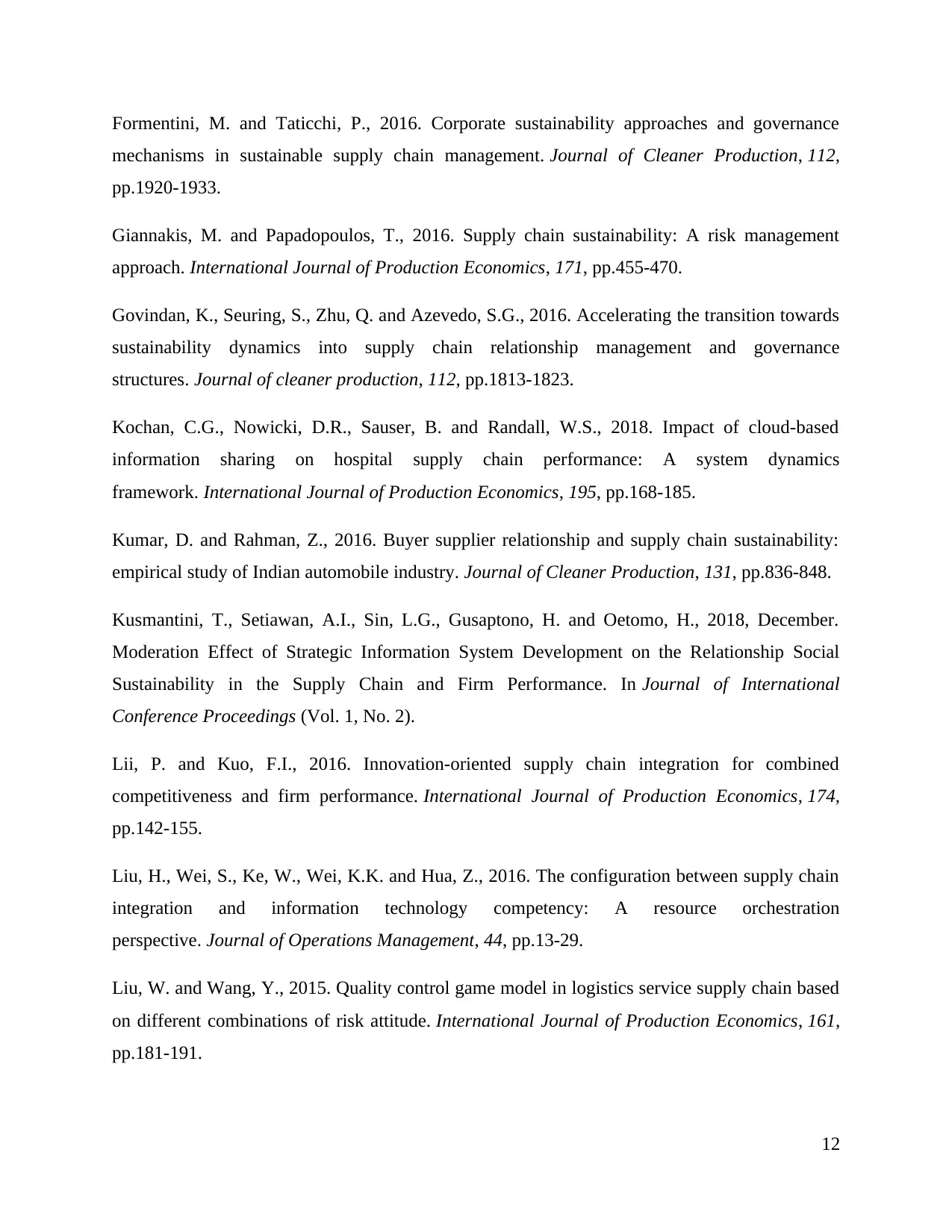
Formentini, M. and Taticchi, P., 2016. Corporate sustainability approaches and governance
mechanisms in sustainable supply chain management. Journal of Cleaner Production, 112,
pp.1920-1933.
Giannakis, M. and Papadopoulos, T., 2016. Supply chain sustainability: A risk management
approach. International Journal of Production Economics, 171, pp.455-470.
Govindan, K., Seuring, S., Zhu, Q. and Azevedo, S.G., 2016. Accelerating the transition towards
sustainability dynamics into supply chain relationship management and governance
structures. Journal of cleaner production, 112, pp.1813-1823.
Kochan, C.G., Nowicki, D.R., Sauser, B. and Randall, W.S., 2018. Impact of cloud-based
information sharing on hospital supply chain performance: A system dynamics
framework. International Journal of Production Economics, 195, pp.168-185.
Kumar, D. and Rahman, Z., 2016. Buyer supplier relationship and supply chain sustainability:
empirical study of Indian automobile industry. Journal of Cleaner Production, 131, pp.836-848.
Kusmantini, T., Setiawan, A.I., Sin, L.G., Gusaptono, H. and Oetomo, H., 2018, December.
Moderation Effect of Strategic Information System Development on the Relationship Social
Sustainability in the Supply Chain and Firm Performance. In Journal of International
Conference Proceedings (Vol. 1, No. 2).
Lii, P. and Kuo, F.I., 2016. Innovation-oriented supply chain integration for combined
competitiveness and firm performance. International Journal of Production Economics, 174,
pp.142-155.
Liu, H., Wei, S., Ke, W., Wei, K.K. and Hua, Z., 2016. The configuration between supply chain
integration and information technology competency: A resource orchestration
perspective. Journal of Operations Management, 44, pp.13-29.
Liu, W. and Wang, Y., 2015. Quality control game model in logistics service supply chain based
on different combinations of risk attitude. International Journal of Production Economics, 161,
pp.181-191.
12
mechanisms in sustainable supply chain management. Journal of Cleaner Production, 112,
pp.1920-1933.
Giannakis, M. and Papadopoulos, T., 2016. Supply chain sustainability: A risk management
approach. International Journal of Production Economics, 171, pp.455-470.
Govindan, K., Seuring, S., Zhu, Q. and Azevedo, S.G., 2016. Accelerating the transition towards
sustainability dynamics into supply chain relationship management and governance
structures. Journal of cleaner production, 112, pp.1813-1823.
Kochan, C.G., Nowicki, D.R., Sauser, B. and Randall, W.S., 2018. Impact of cloud-based
information sharing on hospital supply chain performance: A system dynamics
framework. International Journal of Production Economics, 195, pp.168-185.
Kumar, D. and Rahman, Z., 2016. Buyer supplier relationship and supply chain sustainability:
empirical study of Indian automobile industry. Journal of Cleaner Production, 131, pp.836-848.
Kusmantini, T., Setiawan, A.I., Sin, L.G., Gusaptono, H. and Oetomo, H., 2018, December.
Moderation Effect of Strategic Information System Development on the Relationship Social
Sustainability in the Supply Chain and Firm Performance. In Journal of International
Conference Proceedings (Vol. 1, No. 2).
Lii, P. and Kuo, F.I., 2016. Innovation-oriented supply chain integration for combined
competitiveness and firm performance. International Journal of Production Economics, 174,
pp.142-155.
Liu, H., Wei, S., Ke, W., Wei, K.K. and Hua, Z., 2016. The configuration between supply chain
integration and information technology competency: A resource orchestration
perspective. Journal of Operations Management, 44, pp.13-29.
Liu, W. and Wang, Y., 2015. Quality control game model in logistics service supply chain based
on different combinations of risk attitude. International Journal of Production Economics, 161,
pp.181-191.
12
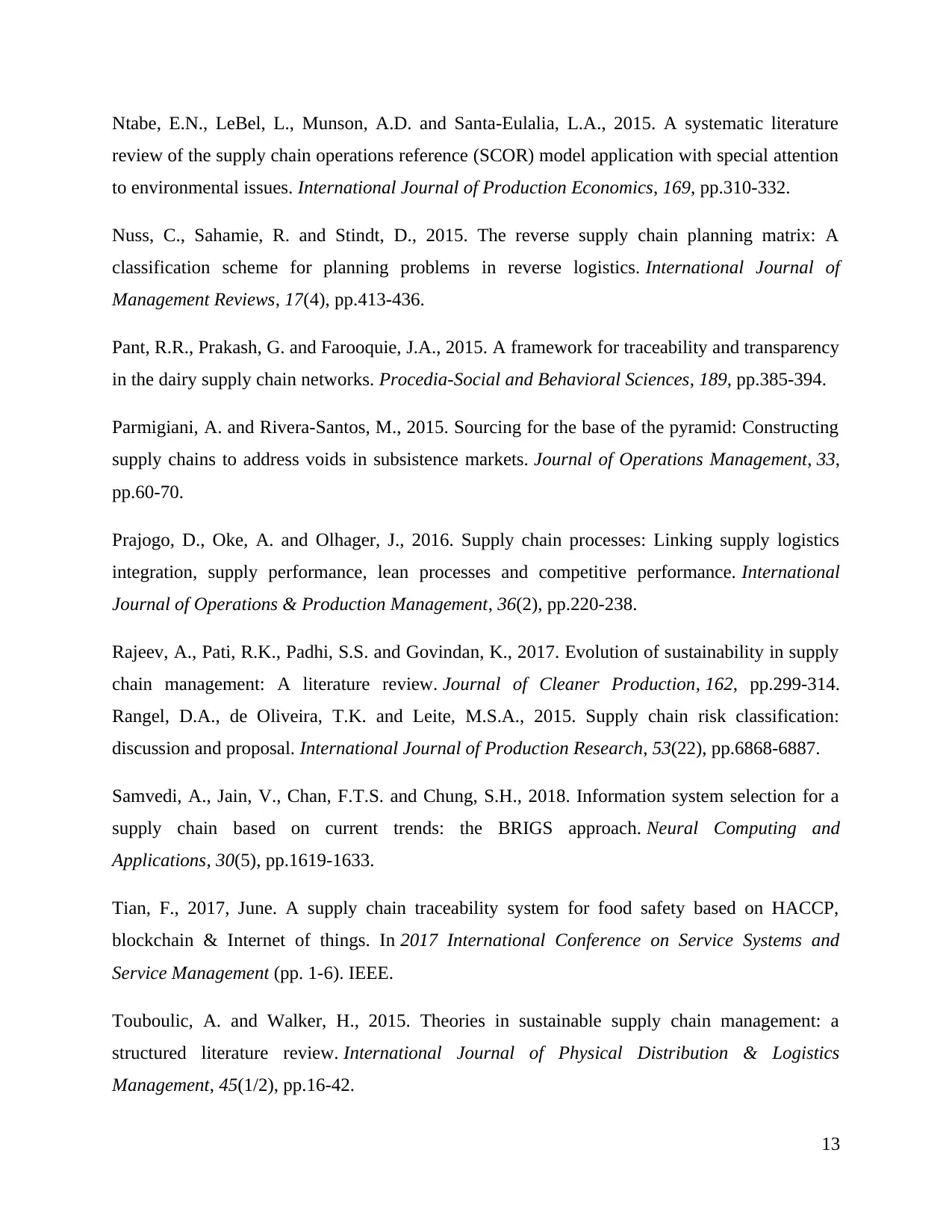
Ntabe, E.N., LeBel, L., Munson, A.D. and Santa-Eulalia, L.A., 2015. A systematic literature
review of the supply chain operations reference (SCOR) model application with special attention
to environmental issues. International Journal of Production Economics, 169, pp.310-332.
Nuss, C., Sahamie, R. and Stindt, D., 2015. The reverse supply chain planning matrix: A
classification scheme for planning problems in reverse logistics. International Journal of
Management Reviews, 17(4), pp.413-436.
Pant, R.R., Prakash, G. and Farooquie, J.A., 2015. A framework for traceability and transparency
in the dairy supply chain networks. Procedia-Social and Behavioral Sciences, 189, pp.385-394.
Parmigiani, A. and Rivera-Santos, M., 2015. Sourcing for the base of the pyramid: Constructing
supply chains to address voids in subsistence markets. Journal of Operations Management, 33,
pp.60-70.
Prajogo, D., Oke, A. and Olhager, J., 2016. Supply chain processes: Linking supply logistics
integration, supply performance, lean processes and competitive performance. International
Journal of Operations & Production Management, 36(2), pp.220-238.
Rajeev, A., Pati, R.K., Padhi, S.S. and Govindan, K., 2017. Evolution of sustainability in supply
chain management: A literature review. Journal of Cleaner Production, 162, pp.299-314.
Rangel, D.A., de Oliveira, T.K. and Leite, M.S.A., 2015. Supply chain risk classification:
discussion and proposal. International Journal of Production Research, 53(22), pp.6868-6887.
Samvedi, A., Jain, V., Chan, F.T.S. and Chung, S.H., 2018. Information system selection for a
supply chain based on current trends: the BRIGS approach. Neural Computing and
Applications, 30(5), pp.1619-1633.
Tian, F., 2017, June. A supply chain traceability system for food safety based on HACCP,
blockchain & Internet of things. In 2017 International Conference on Service Systems and
Service Management (pp. 1-6). IEEE.
Touboulic, A. and Walker, H., 2015. Theories in sustainable supply chain management: a
structured literature review. International Journal of Physical Distribution & Logistics
Management, 45(1/2), pp.16-42.
13
review of the supply chain operations reference (SCOR) model application with special attention
to environmental issues. International Journal of Production Economics, 169, pp.310-332.
Nuss, C., Sahamie, R. and Stindt, D., 2015. The reverse supply chain planning matrix: A
classification scheme for planning problems in reverse logistics. International Journal of
Management Reviews, 17(4), pp.413-436.
Pant, R.R., Prakash, G. and Farooquie, J.A., 2015. A framework for traceability and transparency
in the dairy supply chain networks. Procedia-Social and Behavioral Sciences, 189, pp.385-394.
Parmigiani, A. and Rivera-Santos, M., 2015. Sourcing for the base of the pyramid: Constructing
supply chains to address voids in subsistence markets. Journal of Operations Management, 33,
pp.60-70.
Prajogo, D., Oke, A. and Olhager, J., 2016. Supply chain processes: Linking supply logistics
integration, supply performance, lean processes and competitive performance. International
Journal of Operations & Production Management, 36(2), pp.220-238.
Rajeev, A., Pati, R.K., Padhi, S.S. and Govindan, K., 2017. Evolution of sustainability in supply
chain management: A literature review. Journal of Cleaner Production, 162, pp.299-314.
Rangel, D.A., de Oliveira, T.K. and Leite, M.S.A., 2015. Supply chain risk classification:
discussion and proposal. International Journal of Production Research, 53(22), pp.6868-6887.
Samvedi, A., Jain, V., Chan, F.T.S. and Chung, S.H., 2018. Information system selection for a
supply chain based on current trends: the BRIGS approach. Neural Computing and
Applications, 30(5), pp.1619-1633.
Tian, F., 2017, June. A supply chain traceability system for food safety based on HACCP,
blockchain & Internet of things. In 2017 International Conference on Service Systems and
Service Management (pp. 1-6). IEEE.
Touboulic, A. and Walker, H., 2015. Theories in sustainable supply chain management: a
structured literature review. International Journal of Physical Distribution & Logistics
Management, 45(1/2), pp.16-42.
13
Paraphrase This Document
Need a fresh take? Get an instant paraphrase of this document with our AI Paraphraser
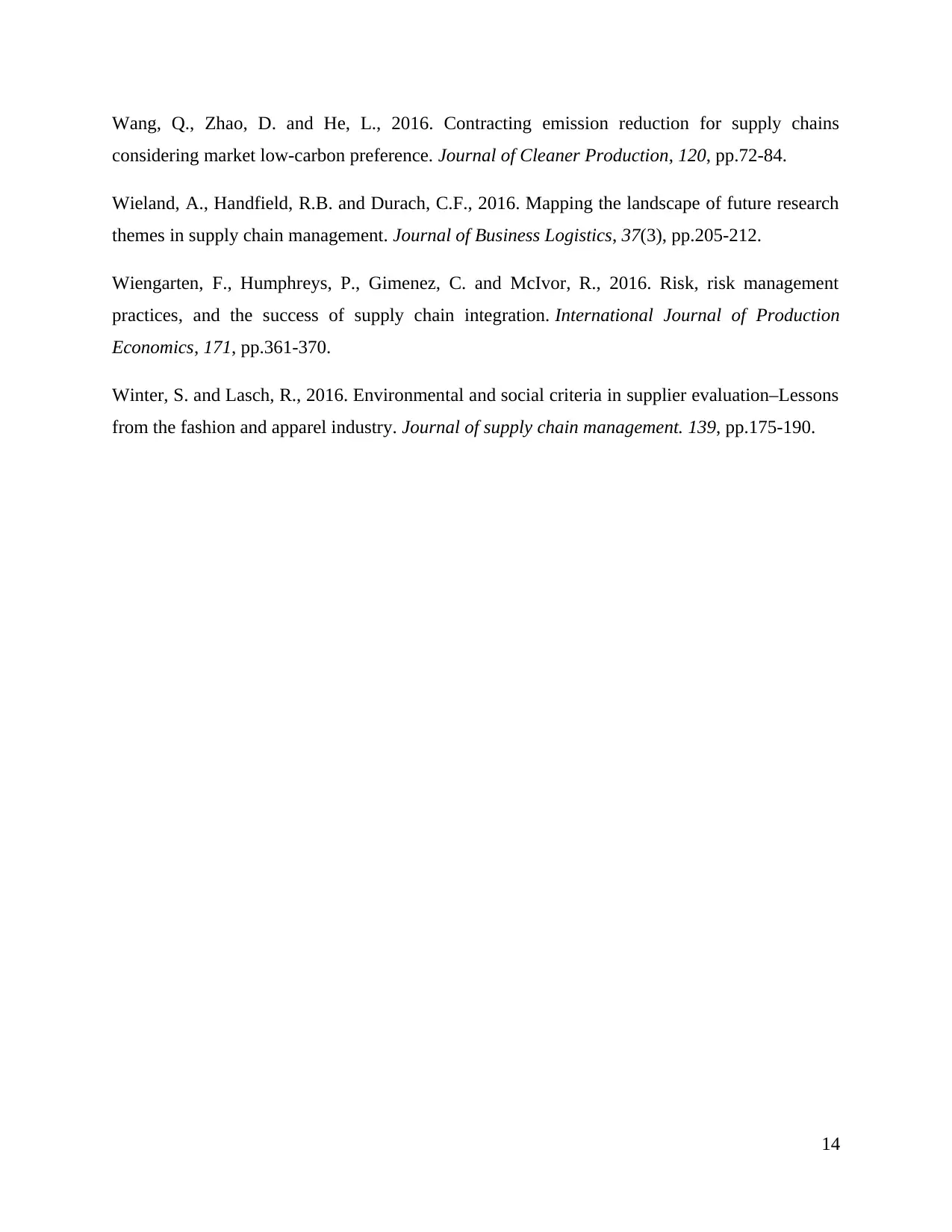
Wang, Q., Zhao, D. and He, L., 2016. Contracting emission reduction for supply chains
considering market low-carbon preference. Journal of Cleaner Production, 120, pp.72-84.
Wieland, A., Handfield, R.B. and Durach, C.F., 2016. Mapping the landscape of future research
themes in supply chain management. Journal of Business Logistics, 37(3), pp.205-212.
Wiengarten, F., Humphreys, P., Gimenez, C. and McIvor, R., 2016. Risk, risk management
practices, and the success of supply chain integration. International Journal of Production
Economics, 171, pp.361-370.
Winter, S. and Lasch, R., 2016. Environmental and social criteria in supplier evaluation–Lessons
from the fashion and apparel industry. Journal of supply chain management. 139, pp.175-190.
14
considering market low-carbon preference. Journal of Cleaner Production, 120, pp.72-84.
Wieland, A., Handfield, R.B. and Durach, C.F., 2016. Mapping the landscape of future research
themes in supply chain management. Journal of Business Logistics, 37(3), pp.205-212.
Wiengarten, F., Humphreys, P., Gimenez, C. and McIvor, R., 2016. Risk, risk management
practices, and the success of supply chain integration. International Journal of Production
Economics, 171, pp.361-370.
Winter, S. and Lasch, R., 2016. Environmental and social criteria in supplier evaluation–Lessons
from the fashion and apparel industry. Journal of supply chain management. 139, pp.175-190.
14
1 out of 14
Related Documents
Your All-in-One AI-Powered Toolkit for Academic Success.
+13062052269
info@desklib.com
Available 24*7 on WhatsApp / Email
![[object Object]](/_next/static/media/star-bottom.7253800d.svg)
Unlock your academic potential
© 2024 | Zucol Services PVT LTD | All rights reserved.





